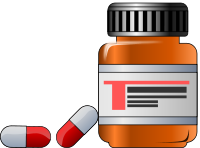Vinca Alkaloids
Mitotic spindle poisons.
Vincristine is obtained from Vinca rosea
Mechanism of Action
– dimeric form, bind tubulin to form tubulin complex
– inhibit polymerization required for formation of microtubules
– mitotic arrest in metaphase, cell are not able to divide
Uses
1. Hematological – ALL / lymphoma / Multiple myloma
2. Pediatric – Wilm’s tumor, Ewing’s sarcoma, neuroblastoma
Toxicity
1. Neurotoxicity – per. sens neuropathy, CN palsies, ataxia, seizures, coma
2. ANS dysfunction
3. SIADH
 Image courtesy of CDC/Amanda Mills
Image courtesy of CDC/Amanda Mills
Vinblastine
Source & Mechanism of Action – as vincristine
Toxicity
- Nausea
- Vomiting
- Alopecia
- Myelosuppression
- Potent vesicant, thrombophlebitis at site of administration
Uses
1. Breast,
2. Germ cell,
3. Lymphomas
Vinorelabine
Semisynthetic compound
Mechanism of Action – as vincristine
Toxicity
a. Nausea
b. Vomiting
c. Myelosuppression
d. Neurotoxicity
e. SIADH
f. Elevated LFTs
Uses
- Non Small Cell Lung cancer,
- Breast cancer
Taxanes
Paclitaxel
Obtained from Taxus brevifolia & T. baccata
Mechanism of Action
- Enhances tubulin polymerization
- Mitotic spindle poison
Microtubules formed are not stable structurally, in absence of tubulin associated proteins, CTP leads to disruption, so known as mitotic spindle poisons.
Uses
Solid tumors ( breast, lung, ovarian, prostate, head/neck, esophagus, bladder, Kaposi’s sarcoma )
Toxicity – hypersensitivity – treated by premedication (H2 blockers, dextramethasone)
– albumin-bound (abraxane) is having no hypersensitivity
Docetaxel
It is a semisynthetic derivative of Paclitaxel
Epipodophyllotoxins
Etoposide & Teniposide
Podophyllotoxin – semisynthetic derivative.
Mechanism of Action
- Inhibit topoisomerase II, uncoiling is inhibited, leading to DNA brakes
- DNA-drug-enzyme – complex is formed, drug acts by binding both DNA and enymes
Uses
- lymphoma
- gastric
- lung
- germ cell
Camptothecins
Topotecan & Irinotecan (prodrug)
- Obtained from Camptotheca acuminata
- Topotecan is prodrug, active metabolite is 1000 times active than parent compound.
Mechanism of Action – inhibit topoisomerase I, interfering with DNA replication
Uses – metastatic colorectal Carcinoma
Adverse Drug Reactions –Myelosuppression / Diarrhea (acute & chronic)
Giving atropine effectively treats diarrhea. Chronic diarrhea appears 2-10 days after treatment.
Hormones & Anti-hormones
Antihormones
a. Anti-estrogen – Tamoxifen
–used in breast Cancer
b. Anti-androgen – Flutamide
–used in prostate Cancer
GnRH agonist – Goserelin / Leuprolide
– transient release of FSH / LH, pulsatile nature is suppressed, effective in releasing sex hormones, estrogen and progesterone
– used in prostate Cancer
d. GnRH antagonist – Abarelix
e. Aromatase inhibitor – Anastrozole
– Aminoglutethimide
– inhibit conversion of androgen to estrogen in fatty tissues of body
– used in prostate / breast Cancer
Asparaginase
Enzyme – produced by bacterial culture e.g. E. coli
Mechanism of Action
Normally L-asparagine present in blood is taken up by malignant cells and used to synthesize proteins, as have no asparagine synthase so rely on external source.
On other hand, normal cells have enzyme for own protein synthesis, when asparaginase enzyme is given, it degrades it into aspartic acid and ammonia, thus malignant cells are unable to produce it.
– Lack of asparagine synthetase – inhibits protein synthesis
Toxicity
– Hypersensitivity
– Neurotoxicity
– Pancreatitis
– Altered clotting factors
Uses – ALL (childhood)
Retinoic acid derivatives
Tretinoin
Used in APL
Mechanism of Action-Induction of terminal differentiation of promyelocytes.
Toxicity
Very typical toxicity profile.
Vit A toxicity
a. Dry skin, mucous membranes
b. Pruritis
c. Conjunctivitis
d. fever
Retinoic acid syndrome
Manifests as:
a. Fever
b. Leukocytosis
c. Weight gain
d. Pleural and pericardial effusion
e. Pulmonary infiltrate
f. Dyspnea
Hyperlipidemias
a. Increased cholesterol
b. Increased TGs
CNS
a. Dizziness
b. Anxiety
c. Agitation
d. Depression
e. Confusion
GIT / Hepatic
a. Abdominal pain
b. Diarrhea
c. Transient increase in LFTs
Monoclonal antibodies
Monoclonal antibodies are the molecules formed against antigen. They are produced by single B-cell line, so called so. They are highly specific towards single type of antigen, so toxic effects are limited because of high specificity.
Production
Antigen of interest is injected into animal e.g. mice, whose immunity is stimulated. B cells against antigen start forming antibodies, which are quantitively very less thus cannot be used clinically. These stimulated B cells are removed and are fused with myeloma tumor cells. Myeloma is a B cell cancer having lost the capacity to form antibodies but having rapid replication or growth rate.
- Hybridoma – B-cell + Myeloma tumor cell
Once fused, B cells also replicate, thus lots of antibodies are produced. Either germ tissue culture is obtained or injected back into animal where grow and give rise to lots of antibodies. Not used because of ethical issues.
Chimeric antibodies may produce hypersensitivity reactions where administered to humans. Humanized by removing major portion of animal origin and replacing it with antibody portion:
- Constant portion human origin
- Antigenic variable portion of animal source.
There are many examples:
- Rituximab – anti CD20 on B lymphocytes
–used in Non Hodgkin’s lymphoma
- Trastuzumab – anti EGFR receptor (epidermal growth factor receptor) – HER-2/neu
–used in metastatic breast Cancer
- Bevacizumab – anti-VEGF-A
–used in metastatic colorectal Cancer
Cytokines
Small protein molecules/peptides normally present in body.
Interferons
- Three forms: Alpha / beta / gamma
- Alpha form is in clinical use.
Mechanism of Action – mainly immunomodulatory
- When immunity is depressed, they enhance it.
- When overexpressed, suppress it.
- Act as Antiproliferative
Uses – IFN-α –
1. CML
2. hairy cell leukemia
3. malignant melanoma
4. kaposi’s sarcoma
5. hepatitis B & C
Toxicity
1. fever
2. chills
3. myalgias
4. headache
5. depression
6. myelosuppression
IL-2
- Malignant melanoma
- metastatic renal cell Carcinoma
Continue Reading
Cancer Chemotherapy -An Introduction
Methotrexate, 5-Fluorouracil, Purine Antagonists and Antibiotics Used in Cancer Chemotherapy
 howMed Know Yourself
howMed Know Yourself




